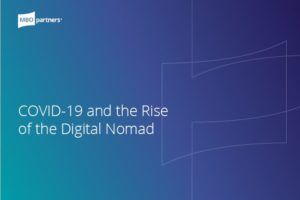Why More Workers are Joining the Digital Nomad Workforce

If you’ve ever aspired to travel the world without quitting your job, know that you’re in good company. According to new estimates from MBO Partners’ 2018 State of Independence in America research, 17 million independent workers aspire to someday become digital nomads, a term referencing workers who embrace a location-independent, technology-enabled lifestyle that allows them to travel and work remotely. An additional 4.8 million Americans already pursue digitally nomadic independent work on a full- or part-time basis.
MBO has produced the first-ever research that quantifies just how many people are currently pursuing nomadic work and lifestyles, as well as the deepest dive today into what type of person makes up this unique and fast-growing population.
Who are Digital Nomads?
As with independent workers at large, digital nomads defy a single definition in terms of age, income level, sex, profession, or motivation.
While, by and large, it’s a young, male population, 31% of nomads are female and more than half (54%) are older than 38. Nomadism is particularly popular among Baby Boomers, as many are delaying retirement or choosing to “unretire” into independent work.
Nomads work full- and part-time. While 38% earn less than $10,000 annually, one in six (about 790,000) earn $75,000 or more each year.
It’s no surprise that professions also vary widely among the digital nomad workforce, but fields like creative services (writers, designers, editors), IT professionals (programmers, developers), and marketing and communications professionals tend to dominate, likely because these jobs can be done across time zones, using digital tools and the Internet.
Why are Digital Nomads Growing?
According to Gallup, 43% of Americans work remotely at least some of the time, and the share of these workers who work remotely 4-5 days per week increased from 24% in 2012 to 31% in 2017. This broader shift to remote work also means hiring firms are familiar and comfortable with hiring remote workers, even if they’re halfway around the world.
Additionally, tools and technology for digital nomads—and remote work in general—has improved by leaps and bounds in recent years. From co-living and co-working spaces, to online talent marketplaces, to tour services dedicated specifically to helping digital nomads, the services available continue to make life easier and more productive for those who wish to work this way.
What is the Future for Digital Nomads?
While it’s always difficult to predict the future, we applaud that digital nomadism has garnered a loyal following, both among practitioners and media alike. Stories of faraway places become more real thanks to the Internet and sites like Instagram, where photos and live video can easily be shared in real time.
MBO’s asked Americans with traditional jobs if they planned on becoming a digital nomad over the next 2-3 years and 11% said yes. Twenty-seven percent said maybe. This translates to roughly 17 million people saying yes, and 42 million people saying maybe.
While we know these numbers are, by and large, aspirational, the data suggests digital nomadism will likely grow substantially over the next few years.
So, we ask our readers this: what are your thoughts? We’d love to hear from you, either on our social channels or via email, about whether you would consider digital nomadism, and why. Or, if you’ve already tried the nomad life, how has it changed you, and what advice do you have for others?
Check out our latest Research Brief, and stay tuned for more Research Briefs from MBO Partners State of Independence in America series. If you have a particular topic of interest, don’t hesitate to reach out.
Read our 2020 Report
Categories
Subscribe to the Insights blog to get weekly insights on the next way of working
Join our marketplace to search for consulting projects with top companies
Learn more about MBO
Are you independent talent?
Learn how to start, run and grow your business with expert insights from MBO Partners
Are you an enterprise?
Learn how to find, manage and retain top-tier independent talent for your independent workforce.
Data driven reports
MBO Partners publishes influential reports, cited by government and other major media outlets.
Informed insights
Research and tools designed to uncover insights and develop groundbreaking solutions.



